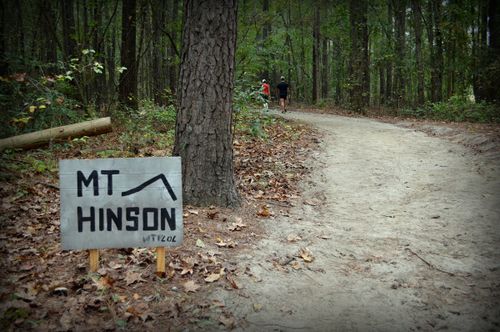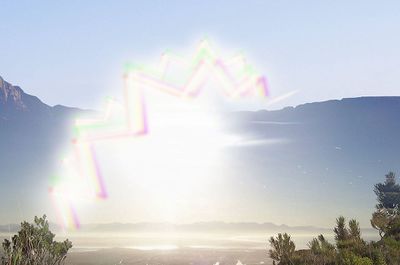Difference between revisions of "2012 Hinson Lake 24 Hour"
From Fellrnr.com, Running tips
User:Fellrnr (User talk:Fellrnr | contribs) (Created page with "[[File:Mt Hinson Trail.jpg|right|thumb|500px|The trail that ascends 'Mount Hinson', which is a shallow if sandy climb the first time around, and then slowly gets steeper with ...") |
(No difference)
|
Revision as of 12:05, 1 October 2012
Hinson Lake is a 24 Hour race around a 1.52 mile sandy trail loop. The first half is quite flat, and the second half has a few rolling sections.
1 What happened
I covered 81 laps for 123 miles, far short of my goal of 140+.
- Mile 40/8 Hours. I swapped from my Modified Nike Free to the Hoka One One shoes I've been trying out. I've modified the Hokas by cutting the toe box open as I do with my Frees. I was having problems with the soles of my feet becoming sore and this looked like it would be a serious problem later. My longest run in the Hokas prior to this was only 10 miles, so this was a risky approach that breaks The Golden Rule of Racing, but the alternative seemed worse.
- Mile 65/11 Hours. At this point I started to have a Migraines Aura that prevented me seeing properly. I have only had a migraine while running once, and never before in a race. I rapidly ate several gel packs and 200mg of caffeine to see if I could abort the migraine. After about half an hour my vision returned and I was left with some mood disturbances but no headache.
- Mile 100/17 Hours. For a few hours my digestive system had been unhappy and uncomfortably hot. Therefore at the 100 mile mark I decided I'd slow down for a bit to bring things under control. The 100 mile mark was a good point for a gentle lap and I also realized the leader had dropped. However, things went rapidly from bad to worse and I had nausea. This was different to what happened to me at Poland and vomiting resolved the nausea within a few minutes. However, my stomach would not tolerate food or liquid from this point on.
- Last 7 Hours. The inability to take fluid or fuel prevented me from making any real progress, and I did just enough to keep a 2 lap lead over the second place runner. I tried a few things, but even water upset my stomach. As far as I can remember I took in about 4oz of Ginger ale, 6oz water, a saltine, around 5 M&Ms, and sucked on 5 gummy bears. My legs stayed strong through to near the end of the race, and I could run well when I needed to, but I was worried that the lack of fluid and fuel could cause me a medical problem. I was also painfully aware that my body was not only burning fat, but also tucking into my muscles to provide energy, which would make the subsequent recovery harder. The stomach problems were either due to me rapidly eating too many gels to abort the migraine, or more likely the migraine itself shut my digestive system down, as nausea and vomiting are common symptoms of migraines.
2 What worked
- Muscular endurance. I was surprised how good my legs felt through the race and I had little DOMS after the race. There could be three factors behind this.
- Downhill training. I did a lot of downhill training for Poland and I believe this gave me a lot of muscular endurance. I found my legs were far better than I expected at both Poland and this race.
- The Morton Stretch. I saw Mike Morton do a short series of stretches while setting the American 24 hour record in Poland. He felt these kept him limber, so used a modified approach, stretching every 3 laps (4.5 miles). This helped a little for the first 50 miles, but was quite remarkable later, giving me the feeling of new legs. (I will do a short post on 'doing the Morton' soon.)
- Hokas. Many runners claim that the Hokas reduce muscular fatigue, but I can't be sure from this run.
- Run/Walk. I took a short walking break on every lap after running the first couple to get clear of the pack.
- Shoes. My Modified Nike Free shoes worked well for the first 50 miles, but did not provide the protection I needed for my soles. The modified Hoka worked better than I expected, giving me amazing protection from the surface. I also found the minimal heal rise and the reduced sole thickness from the ball of the foot to the toes helped keep my biomechanics efficient. However, the fit and inflexibility produced some hotspots and pressure on my Achilles, and they felt heavy. (Full review to follow in a few weeks.)
- Mid race massage. I often find that my hip flexors become painful and tight after about 30 miles, and the pain arrived on cue at Hinson Lake. Some simple massage, digging into the muscle with my thumbs, resolved the problem and it didn't come back.
- Self-crewing. At Hinson Lake I find it easy to be self-crewed. I can take my drinks made up in 8oz bottles and lay all my stuff out on a table. I've found this folding table works remarkably well. Having everything is Ziploc bags helps keep things organized and dry in the rain.
- Fluid and Fuel. In addition to my usual Go Juice, I also made up some DIY Electrolyte Drink, both of which went down well. I also had a few Gels, including Peanut Butter Gus, Accel Gel and PowerGel. The latter were runny and were easier to eat where the Peanut Butter Gu was too thick. To solve this, I put some Gus in a chemical hand warmer.
- Pre-race nutrition. For this race, I aimed to eat less the night before and for breakfast. I suspect that I normally overeat, and this time I slept better and my stomach was happier in the first hour of the race. I also kept my Fiber intake high the day before the race and this seemed to work well.
- Body Weight. For Poland, I'd got my body weight down, and I believe body fat is a huge determinant of performance. After Poland, my weight dropped about three Pounds (1.5Kg) to around 130 (59 kg), but my Body Fat Scales indicate this is mostly due to muscle loss, which is not what I want.
- Garmin 310XT. The battery life of a Garmin running watch is not long enough for a 24 hour with GPS active, but using a FootPod instead works great. I configured my Garmin so that one of the pages of displays included the previous lap time, previous lap distance and average lap time. I could look at my previous lap time at my leisure, rather than noting the time when I cross the line, and I'd also have a running average of my lap times to know what pace I was on. The previous lap distance verified that the calibration of the FootPod was correct. I also wrote on my hand the split times for the various goal distances.
3 What didn't work
- The migraine. It's unclear to me what could have triggered this migraine. It's possible that my blood sugar dropped too low, which is a migraine trigger for me. If I'd have my blood glucose meter, I'd have checked. Given what happened, I'm not sure what else I could have done.
- Cutting out caffeine. I cut out Caffeine as part of my taper for Poland, and continued for the three weeks between Poland and this race, so I was completely off. While this may have helped slightly, the benefit was not worth the effort and in future I will probably just minimize my intake rather than cutting it down totally.
- The Sand. The fine sand at Hinson Lake coating everyone's skin and I found it irritated. I think it may have blocked the skin pores a little, preventing effective sweating. I washed it off my legs a few times, but this was tricky and ineffective. Wearing tights might have been a better option.
- Heat. The weather was generally cool with a high of only 73f/23c, but the humidity was high. This seemed to produce more heat stress than I'd expect, and with hindsight I probably should have used a Jimbo Bandana.

